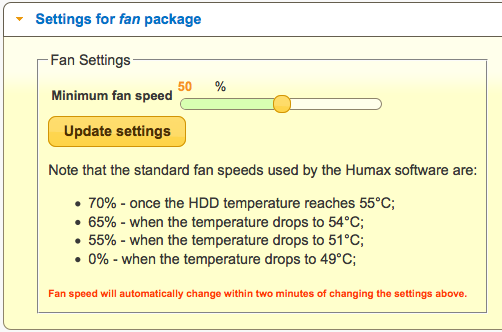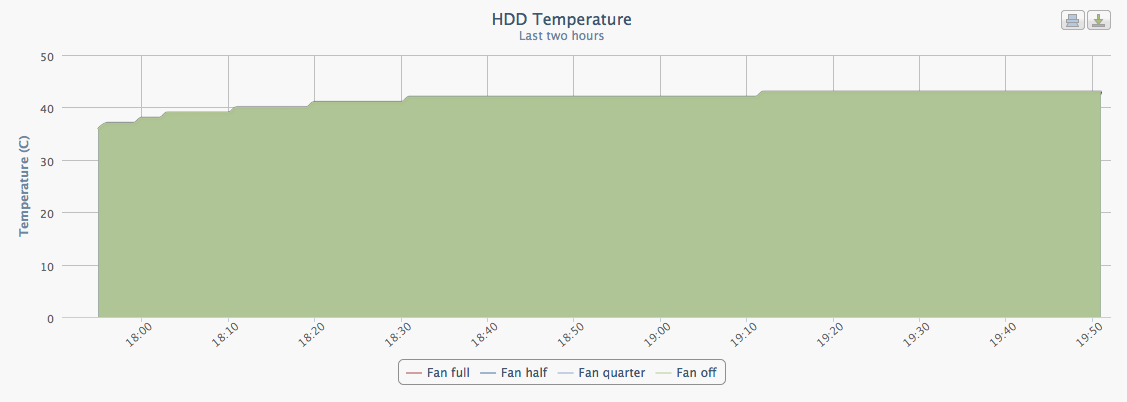BMAX
Active Member
I don't know if the following might help, I wrote it some time ago but never got round to posting it.
"I have been monitoring the HDR-FOX T2 for some time and found, as many others have commented, that the behaviour of the cooling fan is somewhat strange. Just to refresh our memories, nothing seems to happen until after a temperatue level (54C?) is exceeded, whereupon the internal fan starts at full speed, with an associated obtrusive noise. As the temperatue falls, the fan speed reduces in steps, until the temperature falls below 49C, where upon the fan stops. There is invariably an undershoot of several degees, and then the cycle begins again. This seems to be a back to front operation to me.
The observed method of operation results in a see-saw temperature profile with a period of about one hour. I remember from my product qualification days, that temperature cycling is a recognised method of accelerating early electronic component failures during product life testing, albeit using somewhat larger temperature differentials. Hence, I have looked for an alternative method of cooling.
I mounted a twelve volt 3" computer fan via a reduction tube (made from a scrap pieces of plastic gutter down spout), over the case outlet of the existing fan. The fan is powered from the 5v supply available at the USB port, which is only present when the unit is powered up. This produces a continuous gentle, almost completely silent, air flow through the unit, whenever it is powered up.
The result is that the box temperature rises over a period of about an hour to about 20C above ambient and then stabilises. The internal fan never comes on, but of course it is still available in the unlikely event that the temperature should ever riseto 54C. I have had this running for several months and the highest disc temperature I have seen is 45C, which was 19C above ambient.
I consider that the lower operating temperature together with the absence of temperature cycling can only be beneficial for the performance and life of the product. There is also an adequate margin as demonstated by the recent high ambient temperatures and, of course, it does not involve any modification to the box itself."
"I have been monitoring the HDR-FOX T2 for some time and found, as many others have commented, that the behaviour of the cooling fan is somewhat strange. Just to refresh our memories, nothing seems to happen until after a temperatue level (54C?) is exceeded, whereupon the internal fan starts at full speed, with an associated obtrusive noise. As the temperatue falls, the fan speed reduces in steps, until the temperature falls below 49C, where upon the fan stops. There is invariably an undershoot of several degees, and then the cycle begins again. This seems to be a back to front operation to me.
The observed method of operation results in a see-saw temperature profile with a period of about one hour. I remember from my product qualification days, that temperature cycling is a recognised method of accelerating early electronic component failures during product life testing, albeit using somewhat larger temperature differentials. Hence, I have looked for an alternative method of cooling.
I mounted a twelve volt 3" computer fan via a reduction tube (made from a scrap pieces of plastic gutter down spout), over the case outlet of the existing fan. The fan is powered from the 5v supply available at the USB port, which is only present when the unit is powered up. This produces a continuous gentle, almost completely silent, air flow through the unit, whenever it is powered up.
The result is that the box temperature rises over a period of about an hour to about 20C above ambient and then stabilises. The internal fan never comes on, but of course it is still available in the unlikely event that the temperature should ever riseto 54C. I have had this running for several months and the highest disc temperature I have seen is 45C, which was 19C above ambient.
I consider that the lower operating temperature together with the absence of temperature cycling can only be beneficial for the performance and life of the product. There is also an adequate margin as demonstated by the recent high ambient temperatures and, of course, it does not involve any modification to the box itself."
Last edited:




